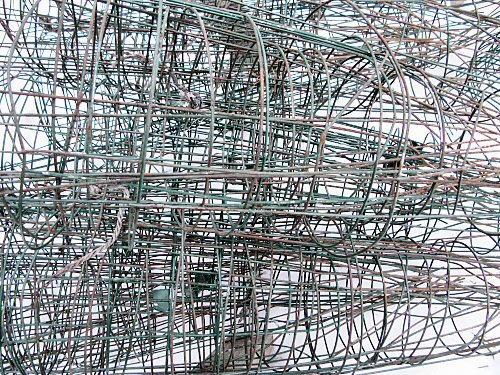
The backdrop of snow turned the puzzle of sorting tomato cages into a bit of abstract art. I don’t use these exclusively, most of the 500-600 plants each year are tied to stakes or sprawled. But the cages get used, too. After every season so far, I’ve been determined to move beyond these lightweight wire gizmos to a more robust tomato support solution, but come spring and the transplanting rush, I end up with even more of ’em. They work great for the first eight weeks after transplanting, but once the toms really get going, they’re kinda useless, too short and not strong enough to hold up the plants. At the end of the season, they have to be hacked and torn out of the tangle of dead toms. And then, they have to be bent back in shape and stacked, tossing the ones where the rings have broken from the spines. I’d left this last little task till today, and now it’s done: the before (above) and after, around 200 cages, stacked and ready to store. Next season, something new!





Mike,
Really enjoy your blog. We check it out daily to see what you’ve posted. We started our own organic produce farm this year and sold at our local Farmer’s Market. We’d suggest a different way of staking your tomatoes that we had great success with this year. We us 16′ rigid wire fencing panels (the kind you’d use to fence livestock in and available at our local livestock feed store), place a steel T-post at each end and one in the center. We run this right down the center of our beds and zip tie the drip irrigation line to the bottom of the fencing. Our beds are 50′ long and we use 3 panels per bed. We plant the tomato plants very close together – 12″ to 18″ apart – and tie them to the fencing as they grow with twine. We try to take out the suckers each week, but they occasionally get ahead of us. This is VERY sturdy and held up even in some pretty strong winds. It’s also really easy to dismantle and store in the fall. Keep up the excellent posts and best wishes for a great growing season in 2009!
I love the first picture… it looks pretty cool!
Annie
http://countrylivinginacariboovalley.blogspot.com/
Very cool abstract art you’ve got going on in these pics! I finally ended up building my cages out of the woven wire they use to reenforce poured concrete. It works wonderfully, although they are huge and hard to store. Kim
Marvelous Jackson Pollack-ish photos!
We are novice tiny farmers. I ‘ve aready gleaned a lot of great info from your blog; thank you!
Everyone has a solution that they like. Here is mine.
8′ treated 2 X 2 s as uprights. I use a long prybar to set a good hole and then hammer the uprights into the soil on about 8′ centers. I use treated 1 X 2 s as cross pieces about a foot apart screwed with drywall screws into the uprights. I can handle any kind of tomatoes including Brandywines which grow the the plant in the little shop of horrors. These structures can be removed and easily stored.
I love reading your blog, I’ve already learned so much in the past weeks since I found it as a localvore resource. The cages *do* look neat. It is almost as if the cages keep giving even after their job of supporting the year’s tomatoes are done. I never knew that you could grow Brandywines in these kinds of cages… how many plants can a cage support?
The big obstacle for me is COST. I grow about 500-600 plants (which isn’t really a lot for a small farm, other local veggie farmers at the market, that sell by the bushel as well as by baskets, grow 2,000+). Spending just $10 per plant is a $5-6,000 investment. Tomatoes are a really important crop, but that’s still a pretty big outlay when there are always so many things to spend on. I could build a 100′ greenhouse for (less than) that.
inadvertentfarmer: My favorite solution so far, based only on ease of care during the season, is the 6×6 concrete reinforcing wire cage. It takes about 5′ to make an 18″ diameter cage (5′ high), plus you need a stake (T-bar or rebar) to support each one for those inevitable super windy days. That’s at least $10 per cage total, it’s expensive. And quite a bit of work at both ends of the season, and storage space.
Susan: The cattle panel solution is great, easier to store, and cheaper! Panels I’ve checked out start at around $30 for 16′, so a 50′ bed requires 3 panels, so that’s $90 per bed, plus another $20 minimum for T-bar/rebar, so say $110 x 20 beds = $2,200. I’ve considered this before, but not with extra close plant spacing. That sounds good, I imagine suckering regularly would make quite a difference in results. My spacing is usually 24″, 25 plants per 50′ bed. At 18″, that’d be 33 plants, so I’d need 5 less beds for 500 toms. 12″ is even more efficient, but I guess needs even more diligent suckering. I should give this a try!
Paul: Wood sounds good, too. I use (untreated, treated’s not allowed in certified organic) 2×2’s for my semi-basket weave tying up method, and they last pretty well, I’ve had some for 4-5 years. I usually pound them in, which does more damage than weather. Pre-digging the holes is good, and ripping 1×2’s and screwnailing them is definitely inexpensive and easily doable. This is a new variation for me. 8’x2x2’s here are $1.65 right now, so it’s kinda inexpensive, with crosspieces, at 8′ centers, around $30/50′ bed! Definitely worth a try as well.
Thanks for all the suggestions and descriptions! I’m absolutely, positively, definitely going to do proper side-by-side trials next season!!!
MangoChild: The cages in my pics aren’t much good when plants get big, Brandywines or most any other indeterminate tomato, especially if you’re not on top of suckering. Paul was referring to his wood staking method. Any cage, the home-style ones, or the ones inadvertentfarmer mentioned hold one plant each. The advantage of well-supported cages is that you don’t have to constantly sucker (remove the branching shoots that constantly pop out, so you only have one or two main stems), you can let the plant grow more freely, so, less work through the year.
Those cages DO look like abstract art! I love your site- very cool- I just got 2 acres myself and am planning to set up a mini-farm. What ever happened with the wiki? Its a great idea! Actually, I want to invite you to a site I started to add your garden to the world map of small food gardens. We just set up a garden wiki there. If you get your tiny farm wiki back up and going maybe we could link to each other! LEt me know.
Best,
Eve Sibley
worldfoodgarden.org